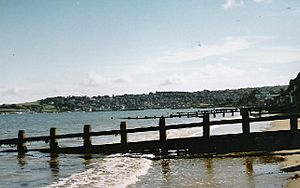Longshore drift facts for kids

Longshore drift is a natural process that moves sand, pebbles, and other beach material along the coastline. It happens because waves hit the beach at an angle. This movement can slowly change the shape of beaches over time.
Contents
How Longshore Drift Works
Longshore drift moves beach material in a special zig-zag pattern. This happens in two main steps:
- Swash: When a wave breaks, the water rushes up the beach. This is called the swash. Because waves usually hit the beach at a slight angle, the swash carries sand and pebbles up the beach in the same angled direction.
- Backwash: After the swash, the water flows straight back down the beach towards the sea. This is called the backwash. Gravity pulls the water and the material it carries directly down the slope of the beach.
This process repeats with each wave. The material is carried up the beach at an angle by the swash, then pulled straight back down by the backwash. This creates a zig-zag path that slowly moves the sand and pebbles along the coast in one main direction. The overall movement of the sand is usually in the same direction as the strongest winds and waves.
Why Longshore Drift is Important
Longshore drift is a very important part of how our coastlines change. It can build up new areas of land, like spits (long, narrow strips of land that stick out into the sea). It can also cause beaches to shrink in some areas if more sand is carried away than is brought in. Understanding longshore drift helps scientists and engineers protect our beaches and coastal areas.
Controlling Longshore Drift
Sometimes, people want to control longshore drift to protect beaches or buildings near the coast. There are different ways to do this:
- Groynes: These are long, low walls built out into the sea from the beach. They are often made of wood, rock, or concrete. Groynes work by trapping sand that is being moved by longshore drift. The sand builds up on one side of the groyne, making the beach wider there. However, this can mean less sand reaches the beach further along the coast, which can cause erosion there. Some people don't like groynes because they can block walking along the beach and change how the beach looks.
- Breakwaters: These are structures built in the water, usually parallel to the shore. They help to break the force of waves before they reach the beach. This reduces the energy of the waves, which in turn reduces how much sand is moved by longshore drift.
- Beach Nourishment: This involves adding new sand to a beach that has lost material due to longshore drift. It's like refilling the beach to make it wider again. This is a more natural-looking solution, but it needs to be done regularly because the new sand will also be moved by the waves.
Images for kids
-
Provincetown Spit, at the northern end of Cape Cod, was formed by longshore drift after the end of the last Ice age.
-
This picture shows how artificial headlands and detached breakwaters are used to manage a coastal area.
See also
 In Spanish: Deriva litoral para niños
In Spanish: Deriva litoral para niños




